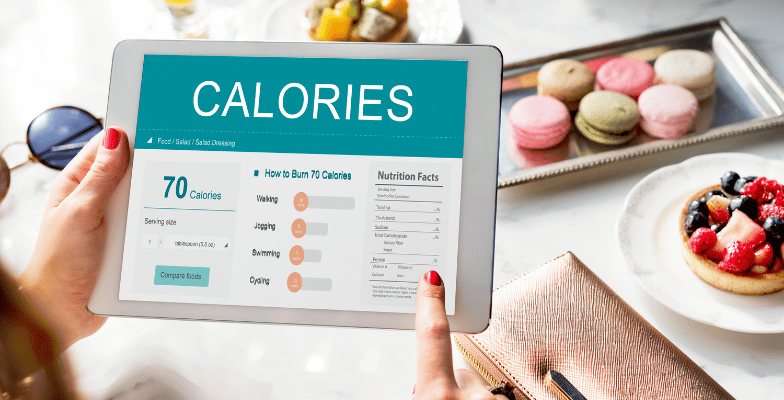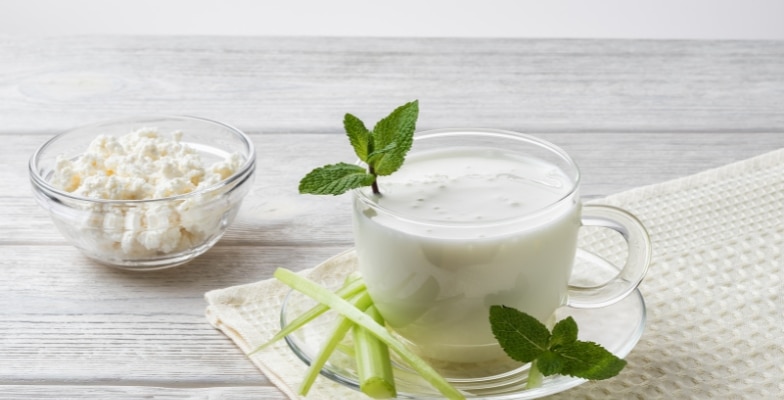TDEE Definition: Total Daily Energy Expenditure

You’ll want to read this article if you want to know what TDEE means and how useful a tool it is when creating a diet for yourself or your clients.
Most of us overeat and underestimate the number of calories we eat. Why do we do that? Well, for starters, we don’t know how many calories we are actually eating on a daily basis.
Try and estimate the number of calories in the two food items below.
4-egg omelet (whole medium eggs) cooked in 1 tbsp (15g) of coconut oil

McDonald’s Meal- 2 Macs and large french fries.

Caloric content is given at the end of this post.
TDEE Definition
Your TDEE- Total Daily Energy Expenditure, is the number of calories your body burns in a 24-hour period while sleeping, working, exercising, playing, and even digesting food.
TDEE is the sum of BMR, TEA & TEF
In other words,
TDEE = BMR + TEA + TEF
In order to understand TDEE, it’s important to understand each of its components in detail. So let’s start with BMR.
Basal Metabolic Rate (BMR)
Basal metabolic rate (BMR) is the amount of energy expressed in calories that a person needs to keep the body functioning at rest.
Just imagine lying down on a sofa the whole day doing nothing at all! How lovely is that? This is just a hypothetical scenario where your body is burning calories to sustain life, i.e., beating of your heart, energy for your brain, breathing- essentially maintaining homeostasis.
BMR accounts for about 50 to 70% of daily energy expenditure. Another name for BMR is RMR, which stands for resting metabolic rate.
There are various formulas for estimating your BMR. Let’s look at the two most popular ones.
The Katch-McArdle Equation
BMR = 370 + (9.79 * lean mass in pounds)
The Mifflin-St. Jeor Equation
For men: BMR = 10 x weight (kg) + 6.25 x height (cm) – 5 x age (years) + 5
For women: BMR = 10 x weight (kg) + 6.25 x height (cm) – 5 x age (years) – 161
If your head has started to spin from looking at these formulas, don’t worry. You are not alone. I used to suck at math, so I always tried and find a shortcut. Finally, I have a simple way out! 🙂 All you have to do is to take your body weight in pounds and multiply it by 10! And voila, you will get your BMR.
So, let’s say you are 170 lbs. If you know your weight in kilograms, then simply multiply it by 2.2 to get your weight in pounds. Now, 170 lbs multiplied by 10 = 1700 calories. This is your BMR.
Your BMR number may vary depending on the equation you use, but let me tell you, you cannot calculate an exact number, so don’t even try. Estimates are fine.
There is another easy way out, and that is to use the TDEE calculator on my website in the Body calculators section.
Thermic Effect Of Food (TEF)
Let’s now discuss the second component of energy expenditure- The Thermic Effect of Food (TEF). The thermic effect of food is the caloric cost of digesting and processing different macronutrients in your diet.
In simple words, when you eat food, a percentage of calories in the food you eat is used to digest and absorb the rest of the food.
When you eat protein, 20-30% of the protein calories are burned by digesting it. This means a high-protein diet will have a higher TEF. When you eat carbohydrates, 5-10% of carbohydrate calories are burned digesting it, and with fats, only 0-3% of calories are burned digesting it.
To put this in tangible terms, if you eat 200 calories of protein, your body will use between 40 and 50 of them to digest it. So the most common estimate for the total thermic effect of food is around 10% of your BMR.
Let’s say your BMR is 1,700 calories. Quite simply, your TEF would be 1,700*10= 170 calories.
Now, we are left with TEA, which stands for the thermic effect of activity.
Thermic Effect Of Activity (TEA)
TEA is the calories you burn through activity, i.e., your training and workouts. It is a function of your BMR, and the formula to calculate it is:
TEA= BMR * Activity Multiplier
Now let’s look at the different activity multipliers.
Sedentary = BMR X 0.2 (little or no exercise, desk job)
Lightly Active = BMR X 0.375 (light exercise/sports 1-3 days/wk)
Moderately Active = BMR X 0.55 (moderate exercise/sports 3-5 days/wk)
Very Active = BMR X 0.725 (hard exercise/sports 6-7 days/wk)
Extra Active = BMR X 0.9 (hard daily exercise/sports and physical job or training 2X/day, i.e., for a marathon, contest, etc.)
Let’s discuss each row in detail.
Sedentary = BMR X 0.2 (Little Or No Exercise, Desk Job)
BMR is the number of calories you expend when you are lying down on the sofa the whole day.
Let’s say you start moving around your house, go to your office, and perform other daily chores. But you don’t work out.
Because of this basic movement, there will be extra calorie burn in addition to your BMR. For this sedentary lifestyle, the thermic effect of activity can be calculated by multiplying BMR by 0.2.
If your client’s BMR is 2,000 calories, with a sedentary lifestyle, their TEA = 2,000*0.2= 400 calories.
Lightly Active = BMR X 0.375 (Light Exercise/Sports 1-3 Days/Wk)
You can put your clients in the category of lightly active if they do some light movement 2-3 times a week. These movements may include any of the following performed a few times a week:
Walking for ~60 minutes
Or
30-45 minutes of low-intensity cardio on a treadmill or a recumbent bike
Or
30-45 minutes of yoga/Zumba or any sport where the intensity is low to moderate
Moderately Active = BMR X 0.55 (Moderate Exercise/Sports 3-5 Days/Wk)
Your client is moderately active if they do either of the following activities:
Moderate-to high-intensity strength training 3-4 times a week and cardiovascular training 2-3 times a week. The cardiovascular training can be either on a cardio machine or through yoga, Zumba, or bodyweight/HIIT workouts.
Or
Play an outdoor sport like football, cricket, rugby, or tennis for 60-90 minutes 3-4 times a week.
Please note in both the lightly active and moderately active categories; your clients have a desk job. This means that beyond these workouts, their step count is limited to ~5000 steps a day.
Very Active = BMR X 0.725 (Hard Exercise/Sports 6-7 Days/Wk)
This category is reserved for people who are very active throughout the day. Their step count is easily over 10,000 steps, and may go up to 15,000 steps per day at least five times a week. In addition to their active lifestyle, they take part in either of the following activities:
Moderate-to high-intensity strength training 5-6 times a week and coupled with cardiovascular training 2-3 times a week.
Or
Play an outdoor sport like football, cricket, rugby, or tennis for 60- 90 minutes 5-6 times a week.
Extra Active = BMR X 0.9 (Hard Daily Exercise/Sports And Physical Job Or Training 2X/Day, i.e., For A Marathon, Contest Etc.)
In the extra-active category are athletes who work hard—real hard. They take part in either of the following activities:
Moderate-to high-intensity strength training 7-10 times a week coupled with cardiovascular training 3-5 times a week. This means they often work out twice a day, a few times a week.
Or
They are professional athletes/bodybuilders who spend 3-4 hours every day playing their sport.
Most athletes also have a very strict schedule that includes a few strength training sessions combined with cardiovascular training.
Pro Tip
Be conservative when selecting an activity multiplier for yourself or your clients. For example, I do moderate-to high-intensity weightlifting.
I combine it with 3-4 HIIT bodyweight sessions every week. My step count averages 7,000 steps per day or around 50,000 steps per week. So I put myself in the moderately active category.
TDEE Calculation
Now that we have figured out the three components of energy expenditure let’s figure out TDEE.
We know that TDEE = BMR+TEF+TEA.
Let’s calculate TDEE for a 170 lbs person who is moderately active.
His BMR is 170*10= 1,700 calories.
His TEF is 10% of 1,700= 170 calories.
And his TEA= 935 calories (1.55)
Therefore, his TDEE= 1700 + 170 + 935 = 2,805 calories
Final Thoughts
Knowing your BMI and TDEE can surely help accelerate your weight loss (or gaining) goals. But try not to get too stressed about them. They simply give you a good starting point to work with.
One last thing I highly recommend is to buy a food scale to weigh your food. Then, the next time you are cooking your meals, simply weigh your food and immediately Google the caloric content of each item. This can help you figure out the number of calories in that food.
Over time you’ll be surprised how good you get at counting calories, as most of us don’t consume more than twenty core ingredients on a regular basis.
And yes, by the way, here is the caloric content of the menu items I asked you about at the beginning of this post:
Calories In The Omelet (cooked by me:))- 440
Calories In The McDonald’s Meal ~1,200
Did you manage to determine your TDEE? If not, I recommend you try the TDEE calculator linked above!
The calculator will provide you with the really accurate TDEE calculations you will find anywhere. It uses the Mifflin-St. Jeor Formula, which is regarded as the most accurate for TDEE calculations.
What do you think about this article? Have any questions? Let me know in the comments below!

Skill-Based Education.
Global Recognition.
Powerful Community Building
Secure a certificate of completion in as little as a day by graduating from one of our free courses.
Get Access to Our Free Courses. No Credit Card Required.

Fabulous Body Membership
Your All-Access Pass to A Fabulous Body & A Rewarding Career
25+ Certificate Courses & Programs, All Included
15 Day Free Trial, 100% Money-Back Guarantee
About Akash Sehrawat
Akash is a creator of 25+ programs and certificate courses in which more than 200,000 students have enrolled both on Udemy and Fabulous Body's native platform. Akash is also an author of three books that can be found on Amazon. His answers on Quora have gathered more than 12 million views in less than a year.











I need to loose 10/ 13 kgs weight to keep my prescribed BMI. Request for non veg, low carb, diet plan of 1200 calories per day. My age 42, weight 76 kgs. Height 157 cms.
Amazingly defined
Thank you:)
Awesome explanation
Thanks you! 🙂
Regards,
Kunal,
Team Fabulous Body
great sir .. thanks for this information .. but link you provided for a calculator does not open
Hi Sarabjit,
Thank you for your kind words.
The first link to the TDEE calculator works. It will take you to the free TDEE calculator on our own website.
The second link belonged to a third party website where we found a really good TDEE calculator but the website is no longer functional. We will update the link soon.
Meanwhile, kindly use the TDEE Calculator from the first link.
Regards,
Kunal,
Team Fabulous Body
This is wonderful.
Hi Peter,
We are glad to know that you liked it.
Regards,
Kunal,
Team Fabulous Body
Hi, I take my TDEE, but I have a few questions that I can not understand, so the total daily energy the calories that I need to burn during my activities(cardio + weight )? I do training 5/6 days bodyweight + cardio 3/4 days per week, normally I burn around 400/500 calories during exercises + 300/400 in cardio. this is the amount that I need to count daily.?
Hi Zulmar,
I will be happy to answer your questions.
When you’re calculating the TDEE, multiply your BMR with an ‘activity multiplier,’ for example 0.55 for moderately active in your case.
Here’s a sample:
If your BMR is 1600 calories
BMR * 0.55
or
1600 * 0.55 = 800
800 Calories will be your TEA or Thermic Effect Of Activity
To get your TDEE, you need to add BMR with TEA & TEF
TEF can be considered as 10% of the sum of the other two, so:
1600 + 800 + 240 = 2640 Calories will be the TDEE in this example.
I hope that this clarifies your doubt.
Regards,
Kunal,
Team Fabulous Body